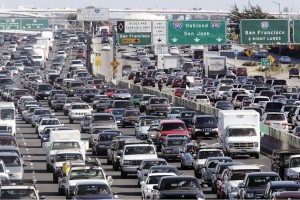
Traffic jams cost hundreds of billions of dollars annually and that figure is only rising, according to a new study.
Not only do traffic jams cause tension, anger and even road rage, they also cost money — billions of dollars annually, according to a new study.
Earlier this year, Inrix calculated that congestion costs U.S. drivers an average of $1,400 per driver each year. That was using 2016 statistics and much of the costs came from time and fuel, but also the increased cost they pay for goods.
For those of you living or who are frequent visitors to Los Angeles, New York, Washington, Atlanta and Dallas, it will come as no surprise that those sprawling metropolises face the highest costs from such bottlenecks, according Seattle-based traffic data firm Inrix.
Using new data, the costs are staggering and escalating. Through 2026, traffic hotspots will cost Los Angeles commuters $90.9 billion and New York commuters $63.9 billion. Boston — at No. 10 in the rankings — faces an $18.9 billion price tag for its 4,158 traffic hotspots. Phoenix, at No. 15, faces a $9.5 billion cost for its 3,441 hotspots.
(Rural America less likely to buckle, more likely to die in a crash. For the story, Click Here.)
To determine the costs, the study looked at major cities’ traffic hotspots, i.e. areas with repeated traffic jams, and ranked them by the duration, length and frequency of those backups, in order to quantify how big a problem traffic jams really are.
“We’re saying, ’Hey, let’s take an honest look and see what’s going on all these roads,” said Bob Pishue, Inrix’s senior economist. “Only when we have fully measured this problem can people and governments get together and solve it.”
The new study focused on 100,000 traffic hotspots in the largest 25 cities in the U.S. in March and April of this year. New York City had the most hotspots, at 13,608. But Los Angeles topped New York in the rankings because of the severity and frequency of its traffic jams.
In Los Angeles, where U.S. 101 South connects to CA-134 and CA-170, the average length of a traffic jam is 355 minutes, and it stretches for an average of four miles. Inrix counted 108 traffic jams at that spot in the two-month period.
The worst hotspot in the country was in Washington, where I-95 South connects to the Fairfax County Parkway. The average traffic jam in that area lasted 33 minutes and was six miles long; there were 1,394 traffic jams in the two-month period.
(Click Here for more about how driver assistance tech saves lives.)
The estimates mostly take into account the value of drivers’ time, which is based on median household income and other factors. The U.S. Department of Transportation has set a value of $12.81 per hour for a commuter and $25.19 per hour for a business traveler. Non-business travel, like running errands, is worth $9.51 per hour.
To get its number, Inrix also factored in 57 cents per minute for the cost of fuel and for the health and environmental cost of increased carbon emissions. The study used the federal government’s set costs for the impact of emissions, Pishue said.
As much as drivers might dream of wide open highways and fast commutes, getting rid of traffic congestion isn’t a realistic goal, Pishue says.
“It is physically possible to eliminate congestion, but do you really want to add 40 lanes to a highway?” he said.
Since a massive infrastructure project seems unlikely and impractical, Pishue suggests cities develop about alternative solutions, like opening roadway shoulders during peak traffic times. Seattle recently spent $11 million to open 1.8 miles of highway shoulder on the I-405 during peak commuting times. Pishue claims traffic flow has improved as a result. Chicago also added lanes to one of its peak hotspots to improve traffic.
(U.S. highway fatalities dip 1% during first half of 2017. Click Here for the full story.)
Many downtown areas can’t add lanes without knocking down buildings; however, retiming traffic lights or managing traffic in and out of the city by changing lane use and speed limits at peak times. In San Francisco, some parking meters charge higher rates at times of peak demand. Commuters can help by working from home or carpooling cut down on traffic.
